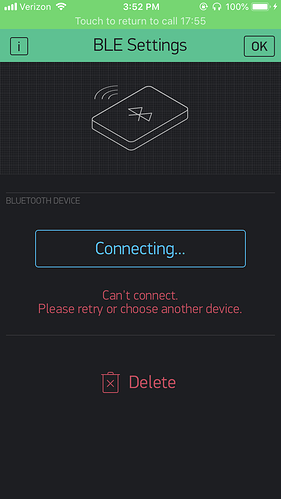Details :
• RedBearLab Arduino Blend V1.0 Connection Via Bluetooth to iPhone
• iiPhone 7 256GB Silver MNAU2LL/A
• Blynk Library version=0.5.4
• Trying to connect with these Blynk app settings:
- Connection Device: RebBearLab Blend Micro
- Connection Type: Bluetooth
The code below compiles with the following Arduino log:
Warning: platform.txt from core 'RedBearLab AVR Boards' contains deprecated recipe.preproc.macros="{compiler.path}{compiler.cpp.cmd}" {compiler.cpp.flags} {preproc.macros.flags} -mmcu={build.mcu} -DF_CPU={build.f_cpu} -DARDUINO={runtime.ide.version} -DARDUINO_{build.board} -DARDUINO_ARCH_{build.arch} {compiler.cpp.extra_flags} {build.extra_flags} {includes} "{source_file}", automatically converted to recipe.preproc.macros="{compiler.path}{compiler.cpp.cmd}" {compiler.cpp.flags} {preproc.macros.flags} -mmcu={build.mcu} -DF_CPU={build.f_cpu} -DARDUINO={runtime.ide.version} -DARDUINO_{build.board} -DARDUINO_ARCH_{build.arch} {compiler.cpp.extra_flags} {build.extra_flags} {includes} "{source_file}" -o "{preprocessed_file_path}". Consider upgrading this core.
Sketch uses 28088 bytes (97%) of program storage space. Maximum is 28672 bytes.
Global variables use 1549 bytes (60%) of dynamic memory, leaving 1011 bytes for local variables. Maximum is 2560 bytes.
/* Comment this out to disable prints and save space */
#define BLYNK_PRINT Serial
#define BLYNK_USE_DIRECT_CONNECT
#include <BlynkSimpleBLEPeripheral.h>
#include <BLEPeripheral.h>
#include <SPI.h>
// You should get Auth Token in the Blynk App.
// Go to the Project Settings (nut icon).
char auth[] = "filled in correctly";
// define pins (varies per shield/board)
#define BLE_REQ 9
#define BLE_RDY 8
#define BLE_RST 4
// create ble serial instance, see pinouts above
BLESerial SerialBLE(BLE_REQ, BLE_RDY, BLE_RST);
void setup()
{
// Debug console
Serial.begin(9600);
SerialBLE.setLocalName("Blynk");
SerialBLE.setDeviceName("Blynk");
SerialBLE.setAppearance(0x0080);
SerialBLE.begin();
Serial.println("Waiting for connections...");
Blynk.begin(SerialBLE, auth);
}
void loop()
{
SerialBLE.poll();
if (SerialBLE) { // If BLE is connected...
Blynk.run();
}
}
When I press play button I get error that device is not connected. I am not sure how to get it connected or what I am doing wrong or if it is even possible with this old hardware.
In the Arduino console I simply endlessly get:
[504680] Connecting…
[513680] Connecting…
[522680] Connecting…
[531680] Connecting…
[540680] Connecting…
[549680] Connecting…
[558680] Connecting…
As a side note I use the code below to connect to the device via the IOs app LightBlue and send hex integers to trigger an Adafruit_NeoPixel. I am trying to use the Blynk app to do this more elegantly.
//"RBL_nRF8001.h/spi.h/boards.h" is needed in every new project
#include <SPI.h>
#include <EEPROM.h>
#include <boards.h>
#include <RBL_nRF8001.h>
#include <Adafruit_NeoPixel.h>
#ifdef __AVR__
#include <avr/power.h>
#endif
//
#define PIN 6
//
//// Parameter 1 = number of pixels in strip
//// Parameter 2 = Arduino pin number (most are valid)
//// Parameter 3 = pixel type flags, add together as needed:
//// NEO_KHZ800 800 KHz bitstream (most NeoPixel products w/WS2812 LEDs)
//// NEO_RGBW Pixels are wired for RGBW bitstream (NeoPixel RGBW products)
Adafruit_NeoPixel strip = Adafruit_NeoPixel(150, PIN, NEO_KHZ800 + NEO_RGBW);
//
//// IMPORTANT: To reduce NeoPixel burnout risk, add 1000 uF capacitor across
//// pixel power leads, add 300 - 500 Ohm resistor on first pixel's data input
//// and minimize distance between Arduino and first pixel. Avoid connecting
//// on a live circuit...if you must, connect GND first.
void setup()
{
//
// For BLE Shield and Blend:
// Default pins set to 9 and 8 for REQN and RDYN
// Set your REQN and RDYN here before ble_begin() if you need
//
// For Blend Micro:
// Default pins set to 6 and 7 for REQN and RDYN
// So, no need to set for Blend Micro.
//
ble_set_pins(9, 8);
// Set your BLE advertising name here, max. length 10
ble_set_name("SAM BLE");
// Init. and start BLE library.
ble_begin();
// Enable serial debug
Serial.begin(57600);
//
strip.begin();
strip.show(); // Initialize all pixels to 'off'
}
unsigned char buf[16] = {0};
unsigned char len = 0;
void loop()
{
// any non-zero number evaluates to TRUE in if statement
// so if there is ble data ready to read from source (ie the phone)
// then if statement below Returns the number of bytes ready for reading.
if ( ble_available() )
{
while ( ble_available() )
{
byte output_now = ble_read();
if (output_now==1)
{
Serial.println(output_now);
colorWipe(strip.Color(0, 0, 255), 0); // Blue
colorWipe(strip.Color(0, 0, 0), 0); // turn off
}
if (output_now==2)
{
Serial.println(output_now);
allOnecolor(strip.Color(0, 255, 0), 1000); // Blue
allOnecolor(strip.Color(0, 0, 0), 0); // Blue
}
if (output_now==3)
{
Serial.println(output_now);
rainbowCycle(0);
colorWipe(strip.Color(0, 0, 0), 0); // turn off
}
}
}
}
// Fill the dots one after the other with a color
void colorWipe(uint32_t c, uint8_t wait) {
for(uint16_t i=0; i<strip.numPixels(); i++) {
strip.setPixelColor(i, c);
strip.show();
delay(wait);
}
}
// Fill the dots one after the other with a color
void allOnecolor(uint32_t c, uint8_t wait) {
for(uint16_t i=0; i<strip.numPixels(); i++) {
strip.setPixelColor(i, c);
}
strip.show();
delay(wait);
}
//Theatre-style crawling lights with rainbow effect
void theaterChaseRainbow(uint8_t wait) {
for (int j=0; j < 256; j++) { // cycle all 256 colors in the wheel
for (int q=0; q < 3; q++) {
for (uint16_t i=0; i < strip.numPixels(); i=i+3) {
strip.setPixelColor(i+q, Wheel( (i+j) % 255)); //turn every third pixel on
}
strip.show();
delay(wait);
for (uint16_t i=0; i < strip.numPixels(); i=i+3) {
strip.setPixelColor(i+q, 0); //turn every third pixel off
}
}
}
}
// Input a value 0 to 255 to get a color value.
// The colours are a transition r - g - b - back to r.
uint32_t Wheel(byte WheelPos) {
WheelPos = 255 - WheelPos;
if(WheelPos < 85) {
return strip.Color(255 - WheelPos * 3, 0, WheelPos * 3);
}
if(WheelPos < 170) {
WheelPos -= 85;
return strip.Color(0, WheelPos * 3, 255 - WheelPos * 3);
}
WheelPos -= 170;
return strip.Color(WheelPos * 3, 255 - WheelPos * 3, 0);
}
// Slightly different, this makes the rainbow equally distributed throughout
void rainbowCycle(uint8_t wait) {
uint16_t i, j;
for(j=0; j<256*5; j++) { // 5 cycles of all colors on wheel
for(i=0; i< strip.numPixels(); i++) {
strip.setPixelColor(i, Wheel(((i * 256 / strip.numPixels()) + j) & 255));
}
strip.show();
delay(wait);
}
}
Any help would be greatly appreciated!!!


 Sticking with WiFi and even USB serial for my stuff.
Sticking with WiFi and even USB serial for my stuff.